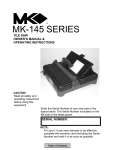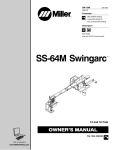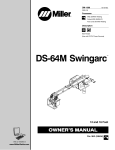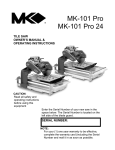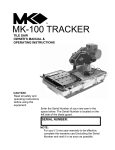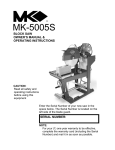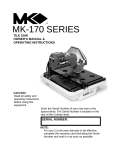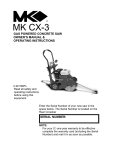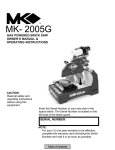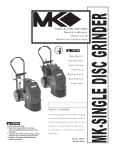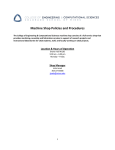Download MK Diamond Products MK-212 Series Owner`s manual
Transcript
MK-212 SERIES TILE SAW OWNER’S MANUAL & OPERATING INSTRUCTIONS CAUTION: Read all safety and operating instructions before using this equipment Enter the Serial Number of your new saw in the space below. The Serial Number is located on the top of the Cutting Head. SERIAL NUMBER: NOTE: For your (1) one year warranty to be effective, complete the warranty card (including the Serial Number and mail it in as soon as possible. INTRODUCTION We at MK Diamond want to congratulate you on selecting the MK-212 Tile Saw. We are certain that you will be pleased with your purchase. MK Diamond takes pride in producing the finest products in the industry. Operated correctly, your MK-212 should provide you with years of quality service. In order to help you, we have included this manual. This owners manual contains information necessary to operate and maintain your MK-212 safely and correctly. Please take a few minutes to familiarize yourself with the MK-212 by reading and reviewing this manual. If you should have questions concerning your MK-212, please feel free to call our friendly customer service department at: 800 421-5830 Regards, MK Diamond MK-212 Revision 10/05, Effective Date October 4, 2005 Page 2 TABLE OF CONTENTS Page SAFETY: Safety Messages Damage Prevention Message General Safety Precautions and Hazard Symbols California Proposition 65 Message Electrical Requirements and Grounding Instructions Tile Saw Specific Warnings Lockout Safety Label Locations Product Specifications 4 4 4 5 6 7 7 8 8 UNPACKING, TRANSPORT, UNIVERSAL STAND, and ASSEMBLY Unpacking Contents Transport Assembly 9 9 10 11 SETUP, ADJUSTMENT AND OPERATION Setup Adjustment and Operation Cleanup 16 19 22 MAINTENANCE AND TROUBLESHOOTING Maintenance Troubleshooting 24 30 EXPLODED VIEW AND PARTS LIST Exploded View Parts List 35 39 THEORY Theory of Diamond Saws 43 ACCESSORIES Accessories 44 ORDERING and RETURN INSTRUCTIONS Ordering Information Return Material Policy Packaging Instructions Authorized Service Centers 45 45 45 45 Manual Part No. 159862 MK-212 Revision No. 10/05 Revision 10/05, Effective Date October 4, 2005 Page 3 SAFETY Read and follow all safety, operating and maintenance instructions. Failure to read and follow these instructions could result in injury or death to you or others. Failure to read and follow these instructions could also result in damage and/or reduced equipment life. SAFETY MESSAGES: Safety messages inform the user about potential hazards that could lead to injury, death and/or equipment damage. Each safety message will be preceded by one of the following (3) three words that identify the severity of the message. KEEP CHILDREN AWAY. All visitors and children should be kept a safe distance from work area. MAKE THE WORKSHOP KID PROOF. Make the workshops kid proof by using padlocks, master switches or by removing starter keys. Not following instructions WILL lead to DEATH or SERIOUS INJURY DO NOT FORCE THE TOOL. A power tool will do a job better and safer operating at the rate for which it was designed. Not following instructions COULD lead to DEATH or SERIOUS INJURY USE THE RIGHT TOOL. Do not force a tool or an attachment, to do a job that it was not designed to do. Not following instructions CAN lead to injury USE THE PROPER EXTENSION CORD. If using an extension cord make sure it is in good condition first. When using an extension cord, be sure to use one heavy enough to carry the current your product will draw. An undersized cord will cause a drop in line voltage that will result in a loss of power and overheating. TABLE 1, Page 7 shows the correct AWG size to use depending on cord length and nameplate ampere rating. If in doubt, use the next heavier gage. The smaller the gage number, the heavier the cord. DAMAGE PREVENTION AND INFORMATION MESSAGES: A Damage Prevention Message is to inform the user of important information and/or instructions that could lead to equipment or other property damage if not followed. Information Messages convey information that pertains to the equipment being used. Each message will be preceded by the word NOTE, as in the example below. NOTE: Equipment and/or property damage may result if these instructions are not followed. GENERAL SAFETY PRECAUTIONS AND HAZARD SYMBOLS: In order to prevent injury, the following safety precautions and symbols should be followed at all times! Safety Precautions: KEEP GUARDS IN PLACE. In order to prevent injury, keep guards in place and in working order at all times. REMOVE ADJUSTING KEYS AND WRENCHES. Form a habit of checking to see that keys and adjusting wrenches are removed from the power tool before it is turned on. KEEP WORK AREA CLEAN. Cluttered work areas and benches invite accidents. DO NOT USE IN DANGEROUS ENVIRONMENTS. Do not use power tools in damp or wet locations nor expose them to rain. Always keep the work area well lighted. MK-212 WEAR PROPER APPAREL. Do not wear loose clothing, gloves, neckties, rings, bracelets, or other jewelry that may be caught in moving parts. Non-slip footwear is recommended. Wear protective hair covering to contain long hair. ALWAYS USE SAFETY GLASSES. Safety glasses should always be worn when working around power tools. In addition, a face, dust mask or respirator should be worn if a cutting operation is dusty. Everyday eyeglasses only have impact resistant lenses and may not prevent eye injury-they are NOT safety glasses. SECURE WORK. Clamps or a vise should be used to hold work whenever practical. Keeping your hands free to operate a power tool is safer. DO NOT OVERREACH. Keep proper footing and balance at all times by not overreaching. Revision 10/05, Effective Date October 4, 2005 Page 4 SAFETY MAINTAIN TOOLS WITH CARE. Keep tools clean for the best and safest performance. Always follow maintenance instructions for lubricating, and when changing accessories. DISCONNECT TOOLS. Power tools should always be disconnected before servicing or when changing accessories, such as blades, bits, cutters, and the like. REDUCE THE RISK OF UNINTENTIONAL STARTING. on Make sure the ON/OFF Switch is in the OFF position before plugging in a power tool. Hazard Symbols: USE RECOMMENDED ACCESSORIES. Consult the owner's manual for recommended accessories. Using improper accessories may increase the risk of personal or by-stander injury. NEVER STAND ON THE TOOL. Serious injury could occur if a power tool is tipped, or if a cutting tool is unintentionally contacted. CHECK FOR DAMAGED PARTS. Before using a power tool, check for damaged parts. A guard or any other part that is damaged should be carefully checked to determine it would operate properly and perform its intended function. Always check moving parts for proper alignment or binding. Check for broken parts and mountings and all other conditions that may affect the operation of the power tool. A guard, or any damaged part, should be properly repaired or replaced. DIRECTION OF FEED. Always feed work into a blade or cutter against the direction of rotation. A blade or cutter should always be installed such that rotation is in the direction of the arrow imprinted on the side of the blade or cutter. NEVER LEAVE A TOOL RUNNING UNATTENDED – TURN POWER OFF. Do not leave a tool until it comes to a complete stop. Always turn a power tool OFF when leaving the work area, or, when a cut is finished. ELECTRICAL SHOCK! Never touch electrical wires or components while the motor is running. Exposed, frayed or worn electrical motor wiring can be sources of electrical shock that could cause severe injury or burns. MK-212 ACCIDENTAL STARTS! on Before plugging the equipment into an electrical outlet, be sure the ON/OFF Switch is in the OFF position to prevent accidental starting. Unplug the power tool before performing any service operation. ROTATING OR MOVING PARTS! Keep hands, feet, hair, and clothing away from all moving parts to prevent injury. Never operate a power tool with covers, shrouds, or guards removed. Sawing and drilling generates dust. Excessive airborne particles may cause irritation to eyes, skin and respiratory tract. To avoid breathing impairment, always employ dust controls and protection suitable to the material being sawed or drilled; See OSHA (29 CFR Part 1910.1200). Diamond Blades improperly used are dangerous. Comply with American National Standards Institute Safety Code, B7.1 and, Occupational Safety and Health Act covering Speed, Safety Guards, Flanges, Mounting Procedures, General Operating Rules, Handling, Storage and General Machine Conditions. CALIFORNIA PROPOSITION 65 MESSAGE: Some dust created by power sanding, sawing, grinding, drilling, and other construction activities contain chemicals known [to the State of California] to cause cancer, birth defects or other reproductive harm. Some examples of these chemicals are: • Lead, from lead-based paints • Crystalline silica, from bricks and cement and other masonry products and • Arsenic and chromium, from chemically treated lumber For further information, consult the following sources: http://www.oshaslc.gov/sltc/silicarystalline/index.html http://www.oehha.org/prop65/out_of_date/6022kLst A.html Your risk from these exposures varies depending on how often you do this type of work. To reduce your exposure to these chemicals, work in a wellventilated area, and work with approved safety equipment, such as those dust masks that are specially designed to filter out microscopic particles. Revision 10/05, Effective Date October 4, 2005 Page 5 SAFETY ELECTRICAL REQUIREMENTS AND GROUNDING INSTRUCTIONS: In order to prevent potential electrical shock and injury, the following electrical safety precautions and symbols should be followed at all times! In case of a malfunction or breakdown, grounding provides a path of least resistance for electric current to reduce the risk of electric shock. This tool is equipped with an electric cord having an equipment-grounding conductor and a grounding plug. The plug must be plugged into a matching outlet that is properly installed and grounded in accordance with all local codes and ordinances. • Do not modify the plug provided – if it will not fit the outlet; have the proper outlet installed by a qualified electrician • Improper connections of the equipmentgrounding conductor can result in a risk of electric shock. The equipment-grounding conductor is the insulated conductor that has an outer surface that is green, with or without yellow stripes. If repair or replacement of the electric cord or plug is necessary, do not connect the equipment-grounding conductor to a live terminal • Check with a qualified electrician or service personnel if the grounding instructions are not completely understood, or if in doubt as to whether the tool is properly grounded • Use only 3-wire extension cords that have 3prong grounding plugs and 3-pole receptacles that accept the tool's plug • Repair or replace a damaged or worn cord immediately To reduce the risk of electrocution, keep all connections dry and off the ground. A Ground Fault Circuit Interrupter (GFCI) should be provided on the circuit(s) or outlet(s) to be used for the Saw. Receptacles are available having built-in GFCI protections and may be used for this measure of safety. When using an extension cord, the GFCI should be installed closest to the power source, followed by the extension cord and lastly, the saw. This tool is intended for use on a circuit that has an outlet that looks like the one shown in Sketch A of Figure 1. The tool has a grounding plug that looks like the plug illustrated in Sketch A of FIGURE 1. A temporary adapter, which looks like the adapter illustrated in sketches B and C, may be used to connect this plug to a 2-pole receptacle as shown in Sketch B, if a properly grounded outlet is not available. The temporary adapter should be used only until a properly grounded outlet can be installed by a qualified electrician. The green-colored rigid ear, lug, and the like, extending from the adapter, must be connected to a permanent ground such as a properly grounded outlet box. Metal Screw Cover of Grounded Outlet Box Grounding Pin (A) (B) ADAPTER (C) Grounding Means Grounding Pin (D) FIGURE 1 NOTE: Use of a temporary adapter is not permitted in Canada. To avoid the possibility of the appliance plug or receptacle getting wet, position the saw to one side of a wall mounted receptacle. This will prevent water from dripping onto the receptacle or plug. A "drip loop," shown in FIGURE 2, should be arranged by the user to properly position the power cord relative to the power source. The "drip loop" is that part of the cord below the level of the receptacle, or the connector, if an extension cord is used. This method of positioning the cord prevents the travel of water along the power cord and coming in contact with the receptacle. If the plug or receptacle gets wet, DO NOT unplug the cord. Disconnect the fuse or circuit breaker that supplies power to the tool. Then unplug and examine for presence of water in the receptacle. Power Cord Power Tool Supporting Surface Drip Loop FIGURE 2 MK-212 Revision 10/05, Effective Date October 4, 2005 Page 6 SAFETY Use only extensions cords that are intended for outdoor use. These extension cords are identified by a marking "Acceptable for use with outdoor appliances; store indoors while not in use." Use only extension cords having an electrical rating not less than the rating of the product. Do not use damaged extension cords. Examine extension cords before using and replace if damaged. Do not abuse extension cords and do not yank on any cord to disconnect. Keep cords away from heat and sharp edges. Always disconnect the extension cord from the receptacle before disconnection the product form the extension cord. To reduce the risk of electrocution, keep all connections dry and off the ground. Do not touch the plug with wet hands. Use of undersize extension cords result in low voltage to the motor that can result in motor burnout and premature failure. MK Diamond warns that equipment returned to us showing signs of being run in a low voltage condition, through the use of undersized extension cords will be repaired or replaced totally at the customers expense. There will be no warranty claim. To choose the proper extension cord, • Locate the length of extension cord needed in TABLE 1 below. • Once the proper length is found, move down the column to obtain the correct AWG size required for that length of extension cord. Extension Cord Minimum Gage for Length Volts 120V 25 ft. AWG 18 Total Length of Cord in Feet 50 ft. 100 ft AWG AWG 16 16 TABLE 1 150 ft. AWG 14 LOCK OUT: Lockout Eye To prevent accidental starting, and to help ensure your workshop is "Kidproof," this saw is provided with a means to lockout the motor ON/OFF switch. The ON/OFF switch is provided with a Lockout Eye that can be used in conjunction with a padlock to prevent starting the MK-212. TILE SAW SPECIFIC WARNINGS: • • • • • • Wear eye protection Use splash hood for every operation for which it can be used Disconnect saw before servicing, when changing cutting blades, and cleaning Use tool only with smooth edge cutting blades free of openings and grooves Replace damaged cutting blade before operating Do not fill water bath above water fill line MK-212 Revision 10/05, Effective Date October 4, 2005 Page 7 SAFETY SAFETY LABEL LOCATIONS: Safety labels are located according to the table below and the exploded views at the end of this manual. The labels contain important safety information. Please read the information contained on each safety label. These labels are considered a permanent part of your saw. If a label comes off or becomes hard to read, contact MK Diamond or your dealer for a replacement Item 1 2 3 4 5 Location Cutting Head Cutting Head Cutting Head Cutting Head On/Off Switch Description Warning, Read Owner’s Manual Caution, GFCI MK Service Information MK Serial Number Caution, .6 Amps Maximum Part No. 155806 155678 155038 157500 154822 PRODUCT SPECIFICATIONS: The MK-212 is a versatile Tile and Stone Saw. Operated and used according to this manual, the MK-212 will provide years of dependable service. General Description: The MK-212 Tile Saw is engineered as a stand mounted wet tile and stone saw. The saw includes a powerful 115v direct drive AC motor. The saw is capable of cutting tile or stone up to thirty-six (36) inches in length and three (3) inches thick in one pass or twenty-four (24) inches diagonally and one and three-fourths (1-3/4) inches thick in one pass. Motor Specifications: Motor specifications for the MK-212 are listed in Table 2 below. Voltage Motor Amperage Frequency RPM Horse Power Weight 115 v 14 a 60 Hz 3400 rpm 2 hp 226 lbs. Table 2 Blade Capacity: The MK-212 uses a ten (10) inch (254 mm) diameter wet cutting continuous rim MK Diamond blade. Tile Types: The MK-212 can cut a variety of tile types including Porcelain, Terracotta, Marble, Quarry and Slate, or almost any other non-ferrous material. NOTE: The MK-212 is not designed to cut plastic or ferrous (metals) material. MK-212 Revision 10/05, Effective Date October 4, 2005 Page 8 UNPACKING, TRANSPORT, UNIVERSAL STAND and ASSEMBLY UNPACKING: Your MK-212 has been shipped from the factory thoroughly inspected. Only minimal assembly is required. Use proper lifting techniques when lifting the MK-212. If not done, remove the MK-212, Cutting Head and accessory box from the carton. CONTENTS: In your container, you will find one (1) MK-212 Saw, four (4) MK-212 support legs, (1) 10-inch wet cutting continuous rim diamond blade, one (1) cutting guide, one (1) blade wrench, one (1) drain plug, one (1) electric water pump, one (1) pump discharge fitting, one (1) cooling transfer tube, one (1) flow regulating clamp, one (1) owners manual, one (1) pump manual and one (1) warranty card. MK-212 Saw MK-212 Support Legs Diamond Blade Blade Wrench 90° Cutting Guide Alignment Plate 90° Cutting Guide 90° Cutting Guide Hardware 2-Piece Protractor Side Table Drain Plug Electric Water Pump Pump Discharge Fitting Cooling Transfer Tube Flow Regulating Clamp Owners Manual Pump Manual Warranty Card MK-212 Revision 10/05, Effective Date October 4, 2005 Page 9 UNPACKING, TRANSPORT and ASSEMBLY TRANSPORT: 1. The MK-212 weighs approximately two hundred and twenty-six (226) pounds and for that reason should not be transported without a minimum of two persons present. 2. Never transport the MK-212 with water in the Water Pan. To lift the saw, grasp the handles on each end of the Water Pan and lift the entire saw. NOTE: The Cutting Head end will be heavier than the opposite end. Cutting Head Lift Point MK-212 Lift Point Revision 10/05, Effective Date October 4, 2005 Page 10 UNPACKING, TRANSPORT and ASSEMBLY ASSEMBLY: Follow the assembly instructions to prepare your MK-212 for operation. 1. Support Leg Installation: Tighten Loosen Transverse Knob (A) Loosen the Cutting Head Transverse Knob Leg Direction of Movement (B) Move the Cutting Head to one end of the saw Retaining Slot (E) Lift the saw; align the Leg with the Retaining Slot on the saw and the install the leg Loosen 2nd Leg (G) Repeat Steps D through F for the second Leg MK-212 Transverse Knob (C) Tighten the Cutting Head Transverse Knob Wingnut Lift Saw Align Leg (D) Obtain the first Leg Cutting Head Tighten (F) Tighten the Leg Retaining Wingnut Cutting Head Transverse Knob (H) Loosen the Cutting Head Transverse Knob Revision 10/05, Effective Date October 4, 2005 Direction of Movement (I) Move the Cutting Head to the end with the two installed Legs Page 11 UNPACKING, TRANSPORT and ASSEMBLY Tighten Transverse Knob (J) Tighten the Cutting Head Transverse Knob Opposite Legs (K) Install the remaining to Legs on the opposite side of the saw using Steps D through G 2. Diamond Blade Installation: NOTE: When installing the Retaining Screw, do not “cross-thread" and DO NOT over tighten the screw. Loosen Tighten Transverse Knob (A) Loosen the Cutting Head Transverse Knob Cutting Head (B) Move the Cutting Head to one end of the saw Transverse Knob (C) Tighten the Cutting Head Transverse Knob Loosen Retaining Wingnut Loosen (D) Loosen the Blade Guard Pivot Point Retaining Wingnut MK-212 Retaining Wingnut (E) Loosen the Blade Guard Retaining Thumbscrew and open the Blade Guard Revision 10/05, Effective Date October 4, 2005 Open (F) Open the Blade Guard Page 12 UNPACKING, TRANSPORT and ASSEMBLY Loosen Retaining Nut Retaining Nut Outer Flange (G) Loosen the Blade Retaining Nut (H) Remove the Blade Retaining Nut (I) Remove the Outer Flange NOTE: The Diamond Blade will have to be installed onto the MK-212 with the Directional Arrow toward the motor side of the Cutting Head for the blade to be seated correctly. Outer Flange Diamond Blade Directional Arrow (J) Install Diamond Blade onto Blade Shaft Retaining Nut (K) Verify the Directional Arrow of the Blade matches the Directional Arrow of the Blade Guard Seat Retaining Nut (L) Install the Outer Flange Tighten Retaining Nut (M) Install the Blade Retaining Nut MK-212 (N) Verify the Blade Retaining Nut is seated in the Outer Flange Revision 10/05, Effective Date October 4, 2005 (O) Tighten the Blade Retaining Nut Page 13 UNPACKING, TRANSPORT and ASSEMBLY Blade Guard Tighten Close (P) Close the Blade Guard Retaining Wingnut Tighten (Q) Tighten the Blade Guard Retaining Thumbscrew Retaining Wingnut (R) Tighten the Blade Guard Pivot Point Retaining Wingnut 3. 90° Cutting Guide Installation: Alignment Plate Retaining Screw (A) Using the supplied Hex-wrench, loosen and then remove the two back Cutting Surface Retaining Screws Support Extension Support Extension (B) Install the two 90° Cutting Guide Support Extension in place of the Retaining Screws and tighten using a wrench (C) Position the 90° Cutting Guide Alignment Plate over the Support Extensions Tighten 90° Cutting Guide Retaining Screw and Washer (D) Install two Alignment Plate Retaining Screws and Flat Washers through Alignment Plate and into Support Extensions and then tighten using the supplied Hex-wrench MK-212 (E) Install the 90° Cutting Guide onto the Alignment Plate and tighten the Retaining Knob to hold the 90° Cutting Guide in position Revision 10/05, Effective Date October 4, 2005 Page 14 UNPACKING, TRANSPORT and ASSEMBLY 3. Water Pump Preparation: 1. 2. To prevent the possibility electrical shock, the MK-212 MUST be de-energized when preparing the Water Pump for operation. To prevent the possibility of electrical shock, use only MK Diamond qualified replacement parts Cooling Transfer Tube Turn clockwise to tighten Discharge Fitting (A) Install Water Pump Discharge Fitting MK-212 Press on (B) Press one end of the Cooling Transfer Tube onto the Water Pump Discharge Fitting Revision 10/05, Effective Date October 4, 2005 Flow Adjusting Clamp Press on (C) Slide Cooling Flow Adjusting Clamp onto the Cooling Transfer Tube Page 15 SETUP, ADJUSTMENT and OPERATION SETUP: 1. Pre-start Inspection: Prior to beginning work, a pre-start inspection of the saw should be performed. Inspect for cracks or cuts Off Position Inspect the Blade ON/OFF Switch (A) Ensure the ON/OFF Switch is in the OFF position (B) Inspect the Pump Assembly for damage – ensure the cord is free of cracks or cuts (C) Inspect the Diamond Blade for damage – verify the blade is correct for the material being cut Verify ease of movement Inspect for damage (D) Inspect the MK-212 for damage – ensure the cord is free of cracks or cuts (E) Verify the Movable Cutting Head moves freely 3. Water Pump Setup for Operation: The Water Pump can be setup for operation in two ways, External Water Source or Re-circulation. NOTE: If using a dry blade for operation, DO NOT connect the water pump. I. External Water Source: This is the preferred method of cooling. Cooling Transfer Tube Press on (A) Press the free end of the Cooling Transfer Tube onto the Blade Guard Cooling Port MK-212 Press to Connect (B) Connect the Water Pump to the MK-212 Revision 10/05, Effective Date October 4, 2005 Drain Plug (C) Remove the Drain plug Page 16 SETUP, ADJUSTMENT and OPERATION Catch Basin Water Pump in container External Container (D) Place the Water Pump in an external container Cover Pump Suction (E) Fill the external container until water completely covers the Water Pump suction (F) Place an external catch basin below the Water Basin drain hole II. Re-circulation: NOTE: When using the re-circulation method, the water should be changed often for longer pump life. Cooling Transfer Tube Drain Plug Installed Press on (A) Press the free end of the Cooling Transfer Tube onto the Blade Guard Cooling Port Water Pump (B) Connect the Water Pump to the MK-212 (C) Ensure the Drain Plug is installed in the Water Basin Cover Pump Suction (D) Place the Water Pump in the back of the Water Basin MK-212 Press to Connect (E) Fill the Water Basin until water completely covers the Water Pump suction Revision 10/05, Effective Date October 4, 2005 Page 17 SETUP, ADJUSTMENT and OPERATION 2. MK-212 Electrical Cord Setup: 1. Before connecting the MK-212 to a power supply, be sure the voltage, cycle and phase meet the requirements of TABLE 3 below. VOLTAGE – 115V CYCLE – 60 Hz TABLE 3 PHASE – 1 Phase 2. If using an extension cord, make sure the length and wire gauge correspond to the requirements listed in TABLE 1 on page 8. An extension cord that is too small in wire gauge (diameter), or too long in length, will cause the motor to overheat and could cause premature failure. 3. Use an approved Ground Fault Circuit Interrupter (GFCI) 4. Do not cover the motor vents as this could lead to motor overheating. NOTE: In order to avoid breaker tripping, a 20-amp circuit breaker should be used. GFCI GFCI Plugged Into Power Source (A) Plug MK-212 into the GFCI (A GFCI should always be used when operating the MK-170) MK-212 (B) Plug the GFCI into the Power source Revision 10/05, Effective Date October 4, 2005 Page 18 SETUP, ADJUSTMENT and OPERATION ADJUSTMENT and OPERATION: 1. Cutting 90° Straight Edges: DO NOT FORCE THE TOOL. It will do the job better and safer at the rate for which it was designed. Turn counterclockwise to loosen Cutting Guide (A) Position the Adjustable Cutting Guide to desired cut length Stop Cutting Guide Tile Seated (B) Place the tile against the Stop and Cutting Guide (C) Verify the tile is seated against the Stop and Cutting Guide Cooling Flow Points Direction of Cut On Position ON/OFF Switch (D) Turn the motor ON (E) Verify proper cooling flow on both sides of the blade (F) Perform the cut Off Position ON/OFF Switch (G) Turn the motor OFF when work is complete MK-212 Revision 10/05, Effective Date October 4, 2005 Page 19 SETUP, ADJUSTMENT and OPERATION 2. Angle Cutting: NOTE: To cut at an angle, the MK-212 has been designed with a pivoting cutting head. DO NOT FORCE THE TOOL. It will do the job better and safer at the rate for which it was designed. Pivot Knob Pivot Knob Turn counterclockwise to loosen Direction of Pivot (A) Loosen the two Cutting Head Pivot Knobs located on each end of the Cutting Head Cutting Guide (B) Pivot the Cutting Head and retighten the two Pivot Knobs (C) Position the Adjustable Cutting Guide to desired cut length On Position Stop Cutting Guide (D) Place the tile against the Stop and Cutting Guide Tile Seated ON/OFF Switch (E) Verify the tile is seated against the Stop and Cutting Guide (F) Turn the motor ON Off Position Cooling Flow Points Direction of Cut (G) Verify proper cooling flow on both sides of the blade MK-212 ON/OFF Switch (H) Perform the cut Revision 10/05, Effective Date October 4, 2005 (I) Turn the motor OFF when work is complete Page 20 SETUP, ADJUSTMENT and OPERATION 4. Off-angle Cutting: NOTE: To cut angles other than 90º, a Protractor (MK Diamond Part No. -MK) should be used. DO NOT FORCE THE TOOL. It will do the job better and safer at the rate for which it was designed. Retaining Knob Adjustable Cutting Guide Adjustment Direction (A) Remove the Adjustable Cutting Guide (B) Place the Protractor on the side of the cutting table adjust the Protractor to fit the tile being cut and tighten the Retaining Knobs to lock the Protractor Set Cut Angle Retaining Knob (C) Set the desired Cutting Angle and tighten the Retaining Knob On Position Protractor Stop (D) Position the tile against the Protractor and the Stop Tile Seated ON/OFF Switch (E) Verify the tile is seated against the Stop and Protractor (F) Turn the motor ON Off Position Direction of Cut Cooling Flow Points (G) Verify proper cooling flow on both sides of the blade MK-212 ON/OFF Switch (H) Perform the cut Revision 10/05, Effective Date October 4, 2005 (I) Turn the motor OFF when work is complete Page 21 SETUP, ADJUSTMENT and OPERATION 5. Cleanup: NOTES: 1. If an external water source was used, steps A through C may be skipped. 2. Dispose of wastewater in accordance with applicable Federal, State and Local laws. Water Pump External Container Pump Suction (A) Clean the Water Pump suction of all debris (B) Place the Water Pump in an external container Cooling Flow Points (C) Run the saw until clear water is seen at the blade cooling ports (Approx. 1 minute) Ensure the saw is disconnected before completing the remainder of the cleanup process. Off Position GFCI ON/OFF Switch Unplug (D) Ensure the ON/OFF Switch is in the OFF position Soap and Fresh Water (G) Clean the MK-212 with soap and clean water MK-212 (E) Unplug the GFCI from the Power source Water Basin (H) Drain the Water Basin and dispose of the water in accordance with all State, Local and Federal laws Revision 10/05, Effective Date October 4, 2005 (F) Unplug MK-212 from the GFCI Clean Water Basin (I) Clean the Water Basin Page 22 SETUP, ADJUSTMENT and OPERATION Ensure water is not forced into the motor casing when cleaning. Guide Rail (J) Clean the Guide Rail MK-212 Cutting Head (K) Clean the Movable Cutting Head Revision 10/05, Effective Date October 4, 2005 Clean Saw (L) Clean the remainder of the MK-212 Page 23 MAINTENANCE AND TROUBLESHOOTING MAINTENANCE: 1. Maintenance Following Use: To extend the life of the MK-212, the following procedure should be performed after each use. Off Position GFCI Guide Rail ON/OFF Switch (A) Ensure the ON/OFF Switch is in the OFF position (B) Unplug MK-212 (C) Lubricate the Guide Rail Springs Cutting Head (D) Lubricate the Cutting Head (E) Lubricate the Cutting Head springs 2. Monthly Maintenance: The following maintenance should be performed monthly. Inner Flange Diamond Blade (A) Remove the Diamond Blade MK-212 (B) Remove the Inner Flange Revision 10/05, Effective Date October 4, 2005 Inner Flange (C) Clean the Inner Flange Page 24 MAINTENANCE AND TROUBLESHOOTING Inner Flange Blade Shaft (D) Lubricate the Inner Flange Gasket (E) Clean the Blade Shaft Blade Shaft (F) Lubricate the Blade Shaft Diamond Blade (G) Reinstall the Inner Flange and Blade 3. Flow Adjustment: NOTE: If flow to the diamond blade requires adjustment, perform the following actions. Press Tab to restrict Pull Tab to loosen (A) Increase cooling flow by releasing the Flow Adjusting Clamp MK-212 (B) Reduce cooling flow by Pressing down on the Flow Adjusting Clamp Revision 10/05, Effective Date October 4, 2005 Page 25 MAINTENANCE AND TROUBLESHOOTING 4. Diamond Blade Change-out: NOTE: When installing the Retaining Nut do not “cross-thread" and DO NOT over tighten the screw. Loosen Tighten Transverse Knob (A) Loosen the Cutting Head Transverse Knob Cutting Head (B) Move the Cutting Head to one end of the saw Transverse Knob (C) Tighten the Cutting Head Transverse Knob Loosen Retaining Wingnut Loosen (D) Loosen the Blade Guard Pivot Point Retaining Wingnut Retaining Wingnut (E) Loosen the Blade Guard Retaining Thumbscrew and open the Blade Guard (F) Open the Blade Guard Outer Flange Loosen Retaining Nut Diamond Blade (G) Loosen and remove the Blade Retaining Nut MK-212 Open (H) Remove the Outer Flange Revision 10/05, Effective Date October 4, 2005 (I) Remove the old Diamond Blade Page 26 MAINTENANCE AND TROUBLESHOOTING NOTE: The Diamond Blade will have to be installed onto the MK-212 with the Directional Arrow toward the motor side of the Cutting Head for the blade to be seated correctly. Outer Flange Diamond Blade Directional Arrow (J) Install the new Diamond Blade onto the Blade Shaft (K) Verify the Directional Arrow of the Blade matches the Directional Arrow of the Blade Guard Retaining Nut (L) Install the Outer Flange Tighten Seat Retaining Nut Retaining Nut (M) Install the Blade Retaining Nut (N) Verify the Blade Retaining Nut is seated in the Outer Flange (O) Tighten the Blade Retaining Nut Blade Guard Tighten Close (P) Close the Blade Guard MK-212 Retaining Wingnut Tighten (Q) Tighten the Blade Guard Retaining Thumbscrew Revision 10/05, Effective Date October 4, 2005 Retaining Wingnut (R) Tighten the Blade Guard Pivot Point Retaining Wingnut Page 27 MAINTENANCE AND TROUBLESHOOTING 4. Table Removal: NOTE: The Rubber topped cutting table may be removed to replace the rubberized surface or to clean the Water Basin. Alignment Plate Adjustable Cutting Guide Retaining Screws (A) Remove the Adjustable Cutting Guide (B) Remove the 90° Cutting Guide Alignment Plate Hex Wrench Cutting Surface Cutting Surface Retaining Screw (D) Remove all retaining screws using the Hex Wrench provided with the MK-212 Water Basin (G) Clean the Water Basin MK-212 (C) Locate the table retaining screws on both sides of the cutting surface (E) Remove one table Cutting Surface piece (F) Remove the second table piece Retaining Screws (H) To replace the Rubber Cutting Surface, remove the surface retaining screws Revision 10/05, Effective Date October 4, 2005 (I) Reinstall all components removed in steps A through H Page 28 MAINTENANCE AND TROUBLESHOOTING 5. Cutting Head Alignment: NOTE: The alignment of the Cutting Head should be checked periodically to ensure the accuracy of the cut. Blade Guard Combination Square Pivot Knob Vertical Alignment (A) Remove the Blade Guard (B) Using a combination square, check the Blade for vertical alignment Pivot Knob Direction of Pivot Adjusting Screw Adjusting Screw Combination Square (D) Pivot the Cutting Head and retighten the two Pivot Knobs Adjustment Direction (G) Adjust the Guide Rail until it is aligned both vertically and horizontally MK-212 45° Alignment (C) Loosen the two Cutting Head Pivot Knobs located on each end of the Cutting Head (E) Using a combination square, check the Blade for 45° alignment Adjusting Screw (F) Loosen the four Guide Rail Adjusting Screws using a 1/2inch socket Adjusting Screw (H) Tighten the four Guide Rail Adjusting Screws using a 1/2inch socket Revision 10/05, Effective Date October 4, 2005 Page 29 MAINTENANCE AND TROUBLESHOOTING TROUBLESHOOTING: 1. Blade will not cut properly: Correct Direction of Rotation If “Glazed”, Dress Blade If not “Glazed”, go to Step B (A) Check for Smoothness or “Glazing” (Dress blade if needed) If rotation correct, go to Step C If Blade Core is bent, or Arbor is out of round, change Blade If not damaged, go to Step D (B) Check for proper rotation (C) Ensure the Blade Core is not bent and Arbor is not out of round Contact place of purchase or MK Diamond (800 421-5830) to verify blade Return to MK Diamond for Repair If the Blade is correct, go to Step E (D) Verify the blade is correct for the material being used (E) Return to MK Diamond 2. Cooling Flow: If flow exists, go to Step A Cover Pump suction with water Pull Tab to loosen (A) Verify the cooling flow Adjusting Clamp is open MK-212 Go to Step C Pull to Remove (B) Remove the Cooling Transfer Tube from the Blade Guard inlet Revision 10/05, Effective Date October 4, 2005 If flow exist, go to Step D (C) Place Pump into a bucket of water and check flow Page 30 MAINTENANCE AND TROUBLESHOOTING Remove Discharge Fitting Pull to Remove If flow exist, go to Step E Pull Intake Screen to remove If flow exist, go to Step F If Screen clean, go to Step G (D) Remove the Cooling Transfer Tube and check for flow (E) Remove the Pump Discharge Fitting and check for flow (F) Remove the Pump Intake Screen and check for debris – clean the screen if necessary Phillips Screwdriver Check Impeller for damage Cooling Manifold Once Screws removed, go to Step H (G) Remove the 3 Pump Casing Retaining Screws Check for restriction If no damage or restrictions, go to Step I (H) Remove the Pump Casing and check for restriction in the casing. Check the Impeller damage Blade Guard Go to Step J (I) Remove the Blade Guard and the Cooling Manifold NOTE: “Rodding” cooling channels is performed by inserting a small wire rod through the cooling inlet on top of the Blade Guard and directing the rod out through each of the cooling flow tubes located on the underside o the Blade Guard. The cooling channels should be “rodded” until all ports are free of foreign debris. Rod Manifold Return to MK Diamond for Repair If cooling channels clear, go to Step K (J) Rod (clean out) the Cooling Manifold and then recheck flow MK-212 (K) Return to MK Diamond Revision 10/05, Effective Date October 4, 2005 Page 31 MAINTENANCE AND TROUBLESHOOTING 3. Cutting Head Does Not Move Correctly: Check Alignment Clean Guide Rail and Cutting Head if dirty If clean, go to Step B (A) Check that Guide Rail and Cutting Head is clean and clean if dirty Lubricate If lubricated, go to Step C (B) Lubricate the Guide Rail and Cutting Head If aligned, go to Step D (C) Check the Cutting Head alignment Return to MK Diamond for Repair (D) Return to MK Diamond MK-212 Revision 10/05, Effective Date October 4, 2005 Page 32 MAINTENANCE AND TROUBLESHOOTING 4. Blade Stops Turning: On Position If connected go to Step C Verify all plugs connected If not tripped or if re-trip occurs, go to Step D If switch is on go to Step B (A) Check the ON/OFF Switch is in the ON position (B) Verify all plugs are fully connected If less than 20 Amps move saw to 20 Amp circuit Check Breaker 20 Amps or greater If circuit 20 Amp or greater go to Step E (D) Verify the circuit breaker is at least 20 amps – if not, move to 20-amp circuit Reset once if tripped Check Breaker tripped (C) Check to see if the Ground Fault Circuit Interrupter (GFCI) tripped If tripped, reset once, if it trips again, go to step F Check for correct circuit voltage If circuit breaker not tripped go to Step F If voltage is correct, go to Step F (E) Verify circuit breaker not tripped; if it is tripped, reset it once only (F) Check power source voltage is 115V – if not 115v, move to another circuit Return to MK Diamond for Repair (G) Return to MK Diamond MK-212 Revision 10/05, Effective Date October 4, 2005 Page 33 EXPLODED VIEW AND PARTS LIST EXPLODED VIEW: MK-212 Revision 10/05, Effective Date October 4, 2005 Page 35 EXPLODED VIEW AND PARTS LIST MK-212 Revision 10/05, Effective Date October 4, 2005 Page 36 EXPLODED VIEW AND PARTS LIST MK-212 Revision 10/05, Effective Date October 4, 2005 Page 37 EXPLODED VIEW AND PARTS LIST MK-212 Revision 10/05, Effective Date October 4, 2005 Page 38 EXPLODED VIEW AND PARTS LIST PARTS LIST: Item A A1 A2 A3 A5 A6 A7 A8 Description Assembly, MK 212 Accessories Carton, MK 212 Shipping (not shown) Pallet, Shipping (not shown) Manual, Owner’s (not shown) Blade, MK-415 (10” x .08 x 5/8) 10” Wrench, 30mm open end 30deg. Wrench, 5mm Allen Carton, #13 Shipping (8”x 10”) (not shown) Qty 1 1 1 1 1 1 1 1 MK P/N 159860 159861 159862 155619 159978 159979 153738 B B1 B2 B3 B4 B5 B6 B7 Assembly, Frame / Pan Frame / Pan Weldment Plug, 2 ½” Dia, Drain Leg, Stand Screw, 3/8-16 x 3/4 Thumb Label, 1 ¾ x 5” MK Logo Foot, 1 ½” x 1 ½” Rubber Label, MK 212 Title 1 1 4 4 1 4 2 n/a 159419 159858 155397 155398 154335 159977 160669 C C1 C2 C3 C4 C5 C6 Assembly, Table Table, MK 212 Screw, 3/8-16 x 1 Soc. Head Cap Washer, 3/8 SAE Flat Washer, 3/8 Split Lock Mat, MK 212 Table Nut, 1/4-20 Nylock 2 8 8 8 4 36 n/a 159420 156602 150923 150925 159421 159857 D D1 D2 D3 2 2 2 n/a 159418 159856 156177 D4 D5 Assembly, Pivot Post Post, Pivot Screw, Self-Lock Set Cup PT 3/8 – 16 x 1/2" Screw, 1/2 X ¾ Socket Head Shoulder, w/ 3/8-16 X 3/8 Thread Knob, 3/8-16 X 1.5 MK Adjustment Washer, 3/8 SAE Flat 2 2 156770-02 150923 E E1 E2 E3 E4 E5 E6 E7 E8 E9 Assembly, Rail Rail, MK 212 Block, Rail Screw, Flat HD 1/4-20 x 3/4 Screw, 5/16-18 X 1 3/4 Hex Head Cap Washer, 5/16 SAE Flat Washer, 5/16 Split Lock Stop, Rubber Bumper Screw, 10-24 X 1/2 Pan Head Phillips Cap (Self Tapping) Screw, 10-24 X 3/8 Pan Head Phillips Cap (Self Tapping) 1 2 4 4 4 4 2 1 1 n/a 159641 159622 154657 150919 151754 151747 159855 153681 151262 F F1 F2 F3 F4 F5 Assembly, MK 212 Cutting Head Block, Rail Saw Bearing Screw, M10 x 30mm Hex Head Cap Washer, M10 Flat Bearing, Deep Groove Ball (6200-2NSE-C3) Screw, M10 x 20mm Hex Head Cap 1 2 4 4 8 8 159853 160201 160202 160203 160097 160204 MK-212 Revision 10/05, Effective Date October 4, 2005 Page 39 EXPLODED VIEW AND PARTS LIST F6 F7 F8 F9 F10 F11 F12 F13 F14 F15 F16 F18 F19 F20 F21 F22 F23 F24 F25 F26 F27 F28 F29 F30 F31 F32 F33 F35 F36 F37 Shim, 3/8 x 5/8 x .008 Base, Bearing Support Screw, M6 x 20mm Socket Head Cap Bracket, Spring Support Pin, Spring Support Assembly, Cutting Head Pivot Axle Clamp, Cutting Head Pivot Axle Screw, M8 x 25mm Socket Head Cap Arm, MK 212 Swing (Right) Arm, MK 212 Swing (Left) Nut, M24 Hex Stop, Cutting Head Rubber Bumper Screw, M8 x 16mm Socket Head Cap Stand-off, Bearing Support Base Spring, MK 212 Knob, MK 212 Adjustment Washer, 5/16 SAE Flat Cover, Rail Saw, Bearing Screw, M6 x 30mm Hex Head Cap Washer, M6 Split Lock Screw, M6 x 20mm Pan Head Slotted Nut, M6 Hex Knob, Cutting Head Locking Spring, Cutting Head Locking Knob Screw, M6 x 10mm Pan Head Slotted Washer, M6 Flat Wiper, MK 212 Label, Warning, Read Owner’s Manual, 1-3/4 X 3-3/8 Label, Caution, GFCI, 1 X 2 1/8 Label, MK Service Info. 2 1/8 X 1-13/16 8 1 2 1 4 1 2 4 1 1 2 1 1 1 2 1 2 1 4 4 2 2 1 1 8 8 4 1 1 1 160205 160223 160219 160220 160221 160224 160226 160227 160242 160238 160239 160228 160229 160218 160222 160184 151754 160207 160212 160213 160208 160209 160210 160211 160214 160215 160216 155806 155678 155038 G G1 G2 G3 G4 G5 G6 G7 G8 G9 G10 Assembly, 115V Motor Motor, 115 volt, 14 amp 60HZ 1 ½ hp SOGA Cord, 14/3 SJTW, Motor Mount, SOGA Motor Key, SOGA Motor Mount Screw, 5/16-18 X 1 Hex Head Cap Washer, 5/16 Split Lock Screw, 3/8-16 x 1 Flat Head Soc Washer, 3/8 Split Lock Washer, 3/8 SAE Flat Nut, 3/8-16 Hex 1 1 1 2 4 4 4 4 4 4 n/a 159643 159907 159642 159859 151743 151747 154019 150925 150923 101188 GA GA1 GA2 GA3 GA4 GA5 GA6 GA7 GA8 GA9 GA10 Assembly, 230V Motor Motor, 230 volt, 14 amp 50HZ 1 ½ hp SOGA Cord, 3X1.0mm, HAR, PVC, Cable Motor Mount, SOGA Motor Key, SOGA Motor Mount Screw, 5/16-18 X 1 Hex Head Cap Washer, 5/16 Split Lock Screw, 3/8-16 x 1 Flat Head Soc Washer, 3/8 Split Lock Washer, 3/8 SAE Flat Nut, 3/8-16 Hex 1 1 1 2 4 4 4 4 4 4 n/a 159971 159987 159642 159859 151743 151747 154019 150925 150923 101188 MK-212 Revision 10/05, Effective Date October 4, 2005 Page 40 EXPLODED VIEW AND PARTS LIST H H1 H2 H3 H4 H5 H6 H7 H8 H9 H10 H11 H12 H13 H14 H15 H16 H17 H18 H19 H20 H21 H22 H23 H24 H25 H26 Assembly, MK 212 Switch Box, Top / Side Entry, 30A Switch Cover, 30A Switch Box Lever, Actuator, 30A Switch Box Plate, Mounting, 30A Switch Lever, On/Off, 30A Switch Box Bushing, Nylon, 30A Switch Box Seal, Urethane, 30A Switch Box Gasket, 30A Switch Box Switch, 30A/2HP/120V/DPST Screw, 6-32 X 5/16 Flat Head Phillips Machine Screw, 10-24 X 5/16 Pan Head Phillips Machine Screw, 6-32 X 5/8 Pan Head Phillips Machine Screw, 10-24 X 5/16 Slotted Hex Washer Head Grounding Washer, #10 SAE Flat Washer, #10 Lock, Internal Teeth Cord, 14/3 SJTW X 5-15P Power Cord, 18/3 SJTW X 5-15R Pump Bracket, MK 212 Switch Screw, 5/16-18 x 3/4 Hex Head Cap Washer, 5/16 Split Lock Washer, 5/16 Flat SAE Screw, 1/4-20 x 1/2 Pan Head Phillips Cap Washer, 1/4 Split Lock Label, Caution, .6 Amp Max. 1 X 2-1/8 Wire Nut, Yellow Nut, 5/16-18 Hex 1 1 1 2 1 1 1 1 1 6 1 4 1 1 1 1 1 1 2 2 2 2 2 1 1 2 160687 159865 159539 159540 159489 159490 158799 159492 159491 159488 159493 159494 157393 159597 154369 158336 159908 159909 159864 151369 151747 151754 155452 152591 154822 159968 101196 J J1 J2 J3 J4 J5 J6 J7 J8 J9 J10 Assembly, Inner Blade Guard Guard, MK 212 Inner Blade Plate, Serial Number #7 X 5/16 Drive Screw Manifold, MK 212 Water Nut, 3/8-16 Jam Screw, 1/4-20 x ¾ Hex Head Cap Washer, 1/4 Split Lock Washer, 1/4 SAE Flat Guard, Splash Screw, 1/4 - 20 Wing 1 1 2 1 1 4 4 5 1 1 159423 157500 157849 159854 159863 151267 152591 151915 160310 151888 K K1 K2 K3 K4 K5 Assembly, Blade Guard Guard, MK 212 Blade Knob, Davies Stud, 5/16-18 x 1 ½ Washer, 5/16 Flat SAE Wing nut, 5/16-18 Nylock 1 1 1 2 1 159416 151681 153680 151754 151746 L L1 L2 L3 L4 Assembly, Water Pump Pump, Water, G-150A Fitting, Plastic, 1/4 FNPT X 1/4 BARB Hose, Vinyl, 1/4 ID Clamp, Flow, 1/4-1/2 1 1 5’ 1 151271 128397 132951 154394 MK-212 Revision 10/05, Effective Date October 4, 2005 Page 41 EXPLODED VIEW AND PARTS LIST LA LA1 LA2 LA3 LA4 Assembly, 230V Water Pump Pump, G300CV 230V 50/60HZ, Fitting, Plastic, 1/4 FNPT X 1/4 BARB Hose, Vinyl, 1/4 ID Clamp, Flow, 1/4-1/2 1 1 5’ 1 151714 128397 132951 154394 M M1 M2 M3 M4 M5 M6 M7 M8 M9 M10 M11 Assembly, MK 212, 12” Slide Protractor Holder, MK 212 Protractor Clamp, MK 212 Sliding Guide Stud, MK 212 Threaded Holder, Clamp Bushing, MK 212 Swivel Screw, 10-24 x 3/8 Shoulder Clamp, MK 212 Holder Guide, MK 212, 12” Sliding Spring, 5/16 x .028 x 3/8 Holding Clamp Knob, 1/4-20 Rubber Knob, 1/4-20 Rubber Guide, 180° Index 1 1 1 1 1 2 2 1 1 2 1 1 159572 159580 159574 159576 159577 159879 159581 159537 159533 159428-1 159428-2 159443 N N1 N2 N3 N4 Assembly, Antenna Holder, Antenna Antenna Screw, 1/4-20 X 5/16 Socket Head Set Knob, 1/4-20 Rubber 1 1 1 1 1 159980 159981 159983 154226 159428-2 P P1 P2 P3 Assembly, Back Stop Stop, Back Stand off, Back Stop Washer, 3/8 SAE Flat 1 1 2 2 160309 160112 160117 150923 S S1 S2 S3 S4 Assembly, Rip Guide Guide, 15 inch Rip Plate, 15 inch Rip Guide Pressure Washer, 1/4 SAE Flat Knob, 1/4-20 Rubber 1 1 1 1 1 160288 160286 160287 151915 159428-2 159870 159984 155398 157522 159421 159857 160172 159985 155986 153523 153861 153699 Optional Assemblies: Q Assembly, Side Table Q1 Q2 Q3 Q4 Q5 Table, Side Screw, 3/8-16 x 3/4 Thumb Screw, Set Cup PT 10 – 24 x 1/4" Mat, MK 212 Table Nut, 1/4-20 Nylock 1 1 1 3 1 9 R R1 R2 R3 R4 R5 Assembly, Wheel Bracket, MK 212 Wheel Wheel, 8” Washer, SAE Flat Pin, Cotter 1/8 x 1 1/2 Shim, .045THK .75ID 1.25OD 1 2 2 2 2 1 MK-212 Revision 10/05, Effective Date October 4, 2005 Page 42 THEORY THEORY OF DIAMOND BLADES: Diamond blades do not really cut; they grind the material through friction. Diamond crystals, often visible at the leading edge and sides of the rim/segment, remove material by scratching out particles of hard, dense materials, or by knocking out larger particles of loosely bonded abrasive material. This process eventually cracks or fractures the diamond particle, breaking it down into smaller pieces. As a result, a diamond blade for cutting soft, abrasive material must have a hard metal matrix composition to resist this erosion long enough for the exposed diamonds to be properly utilized. Conversely, a blade for cutting a hard, nonabrasive material must have a soft bond to ensure that it will erode and expose the diamonds embedded in the matrix. These simple principles are the foundation of “controlled bond erosion”. Types of Cutting: There are two basic types of cutting-Dry or Wet. The choice of which type of blade to use depends on: • The requirements of the job • The machine/tool utilizing the diamond blade • The preference of the operator In the case of DRY cutting, the overwhelming popularity and quantity of hand-held saws and the flexible nature of MK Diamond blades to professionally handle most ceramic, masonry, stone and concrete materials, make the DRY cutting blade a very attractive tool. When using a DRY blade, the user must be aware of distinct operating practices to ensure optimum performance. DRY cutting blades require sufficient airflow about the blade to prevent overheating of the steel core. This is best accomplished by shallow, intermittent cuts of the material with periods of “free-spinning” (for several seconds) between each cut, to maximize the cooling process. For WET cutting applications, MK has the exact blade to compliment both the material to be cut and the wet cutting machine to be used. During cutting operations, liberal amounts of water act as a coolant to support the cutting effectiveness and longevity of the WET blade. Additionally, using water adds to the overall safety of cutting operations by keeping the dust signature down. Know All You Can About the Material You Wish to Cut MK-212 Revision 10/05, Effective Date October 4, 2005 Page 43 ACCESSORIES ACCESSORIES: ITEM 1. NUMBER DESCRIPTION Various MK-275, Marble Profile Wheel 155619 MK-415, 10” Diamond Blade 152792 Dressing Stone 152610 Ground Fault Circuit Interrupter See Catalog Protractor 159870 Side Table 153567 Foot Switch 2. 3. 4. 5. 6. 7. MK-212 Revision 10/05, Effective Date October 4, 2005 Page 44 ORDERING and RETURN INFORMATION ORDERING INFORMATION: You may order MK Diamond products through your local MK Diamond distributor or, you may order direct from MK Diamond. NOTE: There is a $25.00 minimum order when ordering direct from MK Diamond. All purchases must be made using VISA or MasterCard. When ordering direct from MK Diamond, please have the following information ready before calling: • The Model Number of the saw • The Serial Number of the saw • Where the saw was purchased and when • The Part Number for the part(s) being ordered • The Part Description for the part(s) being ordered All parts may be ordered by calling toll free to – 800 421-5830 or 310 539-5221 and asking for Customer Service. For technical questions, call – 800 474-5594. RETURN MATERIALS POLICY: To expedite the service relative to the return of a product purchased through MK Diamond, please observe the following: NOTE: When returning all items, they must have been purchased within the previous twelve (12) months. • Have the Model Number of the saw • Have the Serial Number of the saw • Have the location of where the saw was purchased • Have the date when the saw was purchased • Contact Customer Service for approval to return the item(s) • Obtain a Returned Goods Number (RGA) authorizing the return • Follow the packaging instructions in the following section • Ensure your item(s) are prepaid to the destination For returned items, call toll free to – 800 421-5830 or 310 539-5221 and ask for Customer Service. For technical questions, call – 800 474-5594 or 310 257-2845. PACKAGING INSTRUCTIONS: • • • • • Remove the Blade guard and Support Angle Assembly Dry the saw before shipping When packing, include the following: MK-212, Diamond Blade, Blade guard and Support Angle Assembly and Adjustable Cutting Guide (Other Accessories are not required) Package the unit in its original container or one of comparable size (do not ship the unit partially exposed) Ensure all parts are secured in the packaging to prevent moving AUTHORIZED SERVICE CENTERS: For quicker repair time, you may contact MK Diamond Customer Service, toll free, at – 800 421-5830 or 310 539-5221 for the Authorized Service Center closest too you. For technical questions, call – 800 474-5594. MK-212 Revision 10/05, Effective Date October 4, 2005 Page 45 MK-212 SERIES TILE SAW OWNER’S MANUAL & OPERATING INSTRUCTIONS CALIFORNIA PROPOSITION 65 MESSAGE: Some dust created by power sanding, sawing, grinding, drilling, and other construction activities contain chemicals known [to the State of California] to cause cancer, birth defects or other reproductive harm. Some examples of these chemicals are: • Lead, from lead-based paints • Crystalline silica, from bricks and cement and other masonry products and • Arsenic and chromium, from chemically treated lumber Your risk from these exposures varies depending on how often you do this type of work. To reduce your exposure to these chemicals, work in a well-ventilated area, and work with approved safety equipment, such as those dust masks that are specially designed to filter out microscopic particles. MK DIAMOND PRODUCTS, INC 1315 STORM PARKWAY, TORRANCE, CA 90509-2803 310 539 5158














































